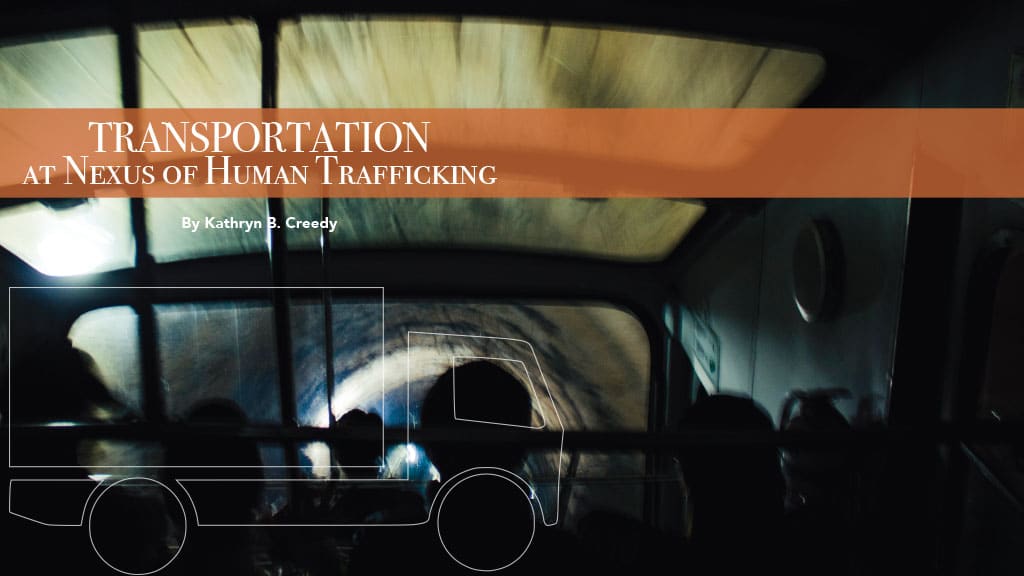The world’s most vulnerable travel by land, sea and air and the destination for an estimated 40 million is either sexual or labor slavery. They may think they are headed to a new job, a new boyfriend, or simply going on vacation and may not even know they are being trafficked. They are the victims of excruciating poverty and unrest. Families may be involved in trafficking, or they may be runaways or homeless.
Transportation is at the nexus of 16 of the 25 different trafficking businesses, a $150 billion global industry, according to the Polaris Project On-Ramps, Intersections, and Exit Routes: A Roadmap for Systems and Industries to Prevent and Disrupt Human Trafficking. Some work for the trucking and shipping industries, moving companies and taxi services, according to The National Human Trafficking Hotline (NHTH).
The underground nature of this crime and the psychological debilitation and manipulation from which victims suffer, make identification and victim outreach exceedingly difficult even when victims are groomed to travel alone.
The difficulty in addressing this is getting it right, as evidenced by the October Southwest Airlines incident when a white mother was suspected of trafficking her bi-racial daughter because they did not match the familial stereotype and they wanted to sit together on an LA-Denver flight. When they arrived in Denver to attend a funeral, they were met on the jetway by police and cross questioned.
In Plain Sight
“Human trafficking is the third-largest illicit trade on the planet, behind drugs and arms,” according to International Transport Workers’ Federation (ITF) which focuses on fisheries and is responsible for calling out operations in Fiji and the Philippines as well as alleging Ireland is ignoring slavery in its fishing industry.
Human trafficking is very visible. It is part of an ecosystem that includes hospital emergency rooms, bus or train terminals, highway rest areas, welcome centers, airplanes or airports, hotel front desks and truck stop parking lots, Polaris reported.
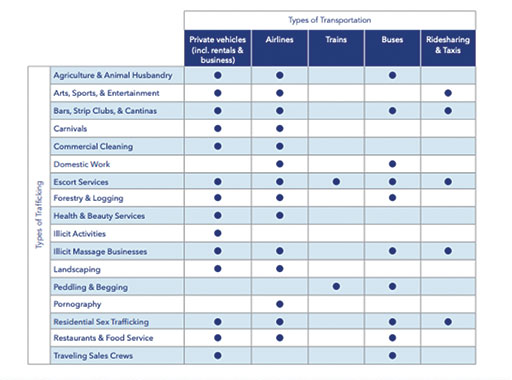
Crimes are not confined to seedy back alleys. Victims may travel by business jets to posh mansions, as exemplified by testimony in Ghislaine Maxwell’s trial for allegedly recruiting minors to be sexually abused by Jeffrey Epstein and his cronies. Reporter Chris Hedges noted the Maxwell trial “will not hold accountable the powerful and wealthy men who were complicit in the sexual assaults of girls as young as twelve Maxwell allegedly procured.”
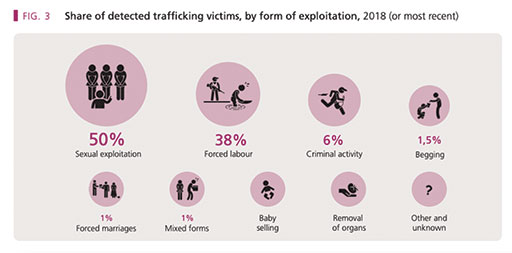
In fact, under U. S. law these rich, powerful men are not just accomplices but sex traffickers themselves, according to ECPAT USA CEO Lori Cohen, who noted the four girls involved in the Maxwell trial traveled a few blocks from their junior high school to Epstein’s mansion in Florida. Former U. S. presidents, a prince, a former Israeli prime minister, titans of industry, numerous politicians, the former head of one of the most prestigious universities in the world and many others are among those that have been tied to Epstein in media reports. Separately, Representative Matt Gaetz (R-FL), who denies wrongdoing, is the subject of a federal investigation on whether he had sex with an underage girl and paid for her to travel with him.
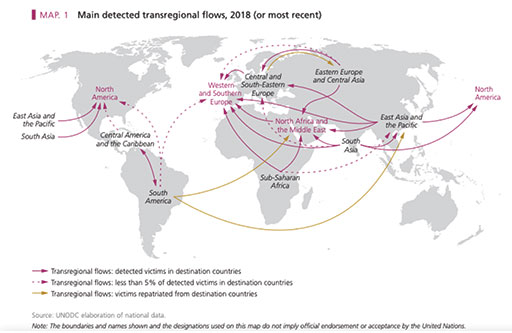
And therein lies the problem. Prosecutions are infinitesimal compared to victims and those why buy children for sex are often not prosecuted.
Victims have few defenses and those that could help, law enforcement, often turn on them as illegal alien perps instead of victims, deporting them back to the hell they fled like the recent tide of Haitians who fled to South America in the wake of the earthquake devastation in 2011. Earlier this year they headed north only to be deported to Haiti, re-devastated by an earthquake, and where the government is useless against the anarchy of street gangs. Similar deportations are happening around the world.
Difficult Definitions
“Definitely, human trafficking intersects with transportation,” Polaris Project communications manager Rafael Flores, told TSI. “For example, coyotes are more directly related to the crime of smuggling than human trafficking. Human trafficking involves fraud, force and/or coercion to obtain some type of labor or commercial sex. But trafficking and smuggling can overlap, and people that have been smuggled can also be trafficked. We focus on the private and public sector because fighting human trafficking will require participation by business and industry partners with resources at a comparable scale to those doing the scale to those doing the trafficking.”
Cohen agrees. “There’s a big difference between smuggling and trafficking,” she told TSI. “Smuggling is a crime against countries and borders while trafficking is a crime against human beings. Smuggling can be consensual for those fleeing persecution or war in countries like Syria and Afghanistan or natural disasters such as those in Central America and Haiti. Others might send their children with smugglers because they otherwise face starvation and parents will do anything to save their children. The challenge is people think smuggling is the same as trafficking.”
Complicating this is the fact trafficking can result from smuggling when gangs hold refugees captive for more than the $10,000 to $40,000 that is the going rate. This puts them in debt, forcing them to be trafficked for labor, put in brothels, restaurants or factories.
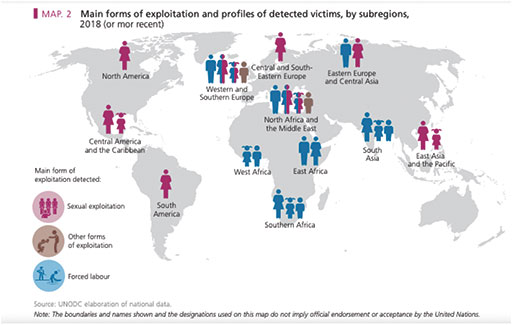
Still, the UN Office of Drugs and Crime, in a 2020 Global Report on Trafficking in Human Persons with data from 148 countries, said migrants make up a significant share of the detected trafficking victims in most global regions. Driven by war, poverty, hope and promises, they walk, take trains or buses. The luckier ones from the Middle East, Asia, Africa and Cuba, wash up in their rickety vessels on U.S., Oceania or European coastlines. The unlucky ones drown when their makeshift boats founder or are roasted to death in overheated trucks abandoned on some remote highway in Europe or America.
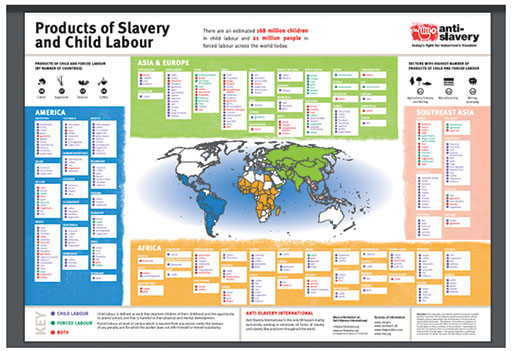
Image source: https://www.antislavery.org/wp-content/uploads/2016/11/products_of_slavery_and_child_labour_2016.pdf
Much of the effort to help victims is increased legislative and immigration law changes, according to the International Labour Organization (ILO), but much more needs to be done.
“Given that a large share of modern slavery traced to migration, improved migration governance is vitally important to preventing forced labor and protecting victims and ensuring fair and effective migration governance,” said ILO in its report. “Almost a quarter of victims of forced labor are exploited outside their country of residence, making good migration governance critical to prevention and protection efforts.”
Transportation Key to Recovery
Polaris’s report provides a road map for change. Trafficking intersects with dozens of legitimate businesses including banks, hospitality, housing, agriculture, fishing and healthcare, which requires them to be part of the solution.
“It’s like a whale breaching the water. It is there for just a moment and then it’s gone,” says Sara Nelson, president AFA-CWA. “The same is true of human trafficking. If we don’t take these moments to help, they could be gone forever.”
“If human trafficking is a business depending on other businesses and partners to flourish, so too must the fight against trafficking be a collective undertaking,” the Polaris report concluded. “Traffickers use banks to store their earnings and buses to move their victims around; hotels are integral to the operations of some sex traffickers, social media is a vital recruitment trawling ground. Stakeholders are already doing innovative work or making powerful commitments to becoming part of the solution.”
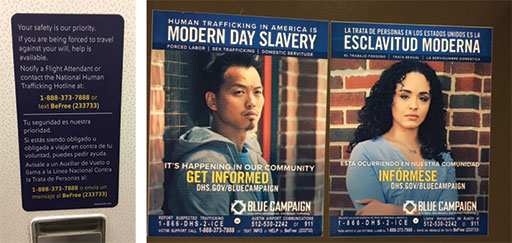
In the forefront is Truckers Against Trafficking (TAT), which includes TAT’s initiative Busing on the Lookout (BOTL). In addition, there is the Association of Flight Attendants (AFA-CWA) and Airline Ambassadors, which was the first aviation organization to develop airline specific training for flight attendants to identify victims and lead them to resources.
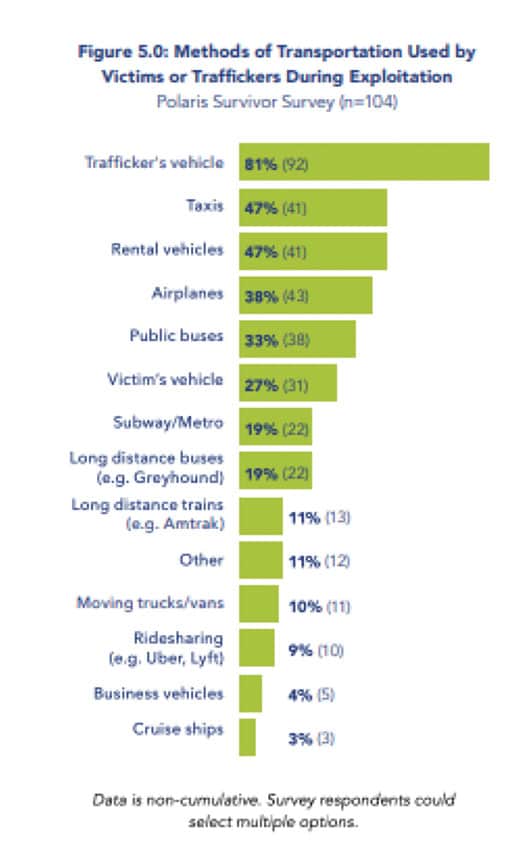
Image source: Page 27 https://polarisproject.org/wp-content/uploads/2018/08/A-Roadmap-for-Systems-and-Industries-to-Prevent-and-Disrupt-Human-Trafficking-Transportation-Industry.pdf
A 2014 Urban Institute report indicated 71 percent of its surveyed victims traveled to the U.S. by air to gateways including Miami, San Francisco, Atlanta and New York before they were trafficked to their final destination.
Polaris said traffickers prefer the comparative anonymity of ground transportation but reported 38 percent of victims it surveyed traveling by plane.
Innocents at Risk Flight Attendant Initiative launched in 2008 with Senior American Airlines Flight Attendant Sandra Fiorini giving flight attendants the NHTH number to report possible human trafficking. Flight attendants began training each other and it grew, Founder Deborah Sigmund told TSI.
“In 2009, I took the Initiative to U.S. Department of Homeland Security (DHS),” said Sigmund. “Hundreds of flight attendants asked for our training brochures — Protecting Women and Children from Human Trafficking. The agency called it a big breakthrough, calling in Customs and Border Patrol, Immigration and Customs Enforcement, the Air Marshals and FBI to collaborate. We were joined by Polaris and American Airlines and we ultimately established Blue Lightning Initiative (BLI). Flight attendant protocol is to report red flags to the pilot who reports directly to DHS. After meeting at an Airline Ambassadors meeting, our organizations agreed to collaborate on a mission trip to the Dominican Republic with her team, educating them on what to look for and how to report. On our return trip, on two flights, the team correctly identified situations of trafficking on Delta and JetBlue flights. DHS rescued 133 children from those reports.”
“We realized then we were on to something and went on to develop the first airline specific training on human trafficking awareness,” Airline Ambassadors CEO Nancy Rivard said. “Training is extremely important so we do it around the world. We need everyone on board because we’ve had incidents in which the pilot didn’t want to get involved.”
In 2015, the Association of Flight Attendants-CWA (AFA-CWA) launched a campaign — 100,000 Eyes in the Sky — to raise awareness and help flight attendants spot and help potential victims.
“We are flight attendants,” AFA-CWA President Sara Nelson told TSI. “We are there to save lives. What is a bigger example than seeing the person on the plane and providing help? It’s like a whale breaching the water. It is there for just a moment and then it’s gone. The same is true of human trafficking. If we don’t take these moments to help, they could be gone forever.”
These organizations were instrumental in driving the adoption of the training module so it could be made standard around the world under the standard training through ICAO. Indeed, The Stop Trafficking on Planes (STOP) Act introduced in Congress had so much support, thanks to the union, it took only a year from introduction to passage. Folded into an FAA funding bill in 2016, it required airlines to provide initial and annual flight attendant training on human trafficking. The effort was expanded in 2018 to include mandatory training for ticket counter agents, gate agents, and other workers who regularly interact with passengers.
“Thankfully, many in the transportation industry are actively taking steps to address it,” said Polaris. It pointed to the Department of Transportation (DOT) work with Amtrak and the Department of Homeland Security’s (DHS) Blue Campaign, a national public awareness campaign designed to educate the public who travel through terminals and airports. It provides on-line training and educational resources to help identify victims and provide links to assistance.
Ground Transport
In Polaris’s survivor survey, 63 percent used some combination of mass transit and publicly accessible transportation services including long-distance buses, taxis and rideshares while 16 percent qualified their contact as “very frequent.”
ECPAT-USA, which wants to network with transit authorities, is engaged in a multi-year cooperative research project on identifying trafficking patterns in mass transit as well as developing communication strategies for employees, riders and potential victims using mass transit.
“At the heart of our mission is training,” Esther Goetsch, TAT’s director of strategic partnerships, told TSI. “When you train folks on human trafficking and how it shows up in our everyday lives, we’ve found the majority of people want to make a difference and are willing to step in on behalf of someone else so providing resources they need empowers them to make a difference.”
TAT is a grassroots organization in the trucking industry and educates, equips, empowers and mobilizes members to fight human trafficking as part of their everyday jobs. The network with which it works includes law enforcement and legislators, schools, carriers, state and national organizations, truck stops, shippers, manufacturers and state agencies. Other organizations working on human trafficking for these now hopeless and helpless millions include the Polaris Project, Anti-Slavery.org, and International Justice Mission.
“We started in 2009,” explained Goetsch, adding reports come from both truckers and truck stop employees. “We focused on trucking, bus and energy industries to create a mobile army of eyes and ears. They outnumber law enforcement and can aid in the recognition and reporting, assist victims and have buyers and traffickers arrested. We developed industry-specific training to let drivers know what human trafficking looks like and how to report it to law enforcement and the NHT Hotline.”
To date, 1.2 million drivers have been trained and registered on TAT’s website as participants. In 2019, it expanded into Canada and now has partners in Mexico. TAT’s busing initiative partners with private companies, state agencies, school districts, public transit providers and associations to get its training resources out to bus industry personnel. Since 2018, over 151,000 members of the bus industry, including over 90,000 school bus drivers, have registered as BOTL trained.
TAT reported to the National Human Trafficking Hotline (NHTH) 734 cases of potential sex trafficking occurring at truck stops. Over 41% of reports since 2016 involve minors.
“When traffickers count on ignorance or apathy to exploit a human being, an opportunity exists for a bystander or trained individual to recognize what is actually happening and take action,” said Polaris. “Every person, working within their sphere of influence, can play a critical role in fighting this crime by effecting social change – whether in reporting the crime, introducing the concept and training to others, being the catalyst for company policy change, or becoming a ‘TAT champion’ and working to raise either personal, corporate or industry involvement to the next level.”
Funding Escape
Polaris reported 54 percent of survivors said access to transportation was a barrier to escape.
“When victims are able to get out, a bus or bus terminal may be the first place they’ll go to find safety or escape,” said Annie Sovcik, director of TAT’s BOTL initiative.
“In those precious moments when they are so vulnerable, boarding a bus may be the only way they can afford to get away,” said Polaris. “Removing the obstacle of paying for transportation can make the difference between a survivor obtaining the help and falling back into the arms of their trafficker.”
Both Delta and Southwest provide flight vouchers and point donations to the NHTH to assist survivors in their efforts to relocate, said Polaris, citing The Delta’s SkyWish Program as a prime example of a company using its resources to ensure survivors have the support they need. Delta SkyMiles members can donate miles to cover the survivor’s airfare to return home or relocate after escaping, receive critical services, reunite with children or families, travel to testify against their traffickers in court, or engage in survivor leadership opportunities. It also cited FedEx and UPS as outstanding trailblazers in this initiative when they partnered with Truckers Against Trafficking (TAT) to receive training on how to identify and respond to trafficking.
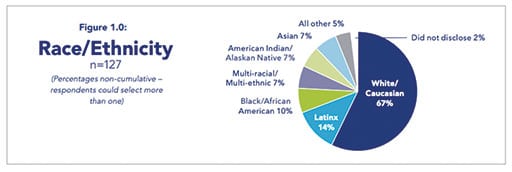
Image source: page 12 https://polarisproject.org/wp-content/uploads/2018/08/A-Roadmap-for-Systems-and-Industries-to-Prevent-and-Disrupt-Human-Trafficking-Transportation-Industry.pdf
The Victims
Trying to quantify the problem is difficult since estimates range from “25 million deprived of their freedom every year,” according to Polaris, to 40.4 million in slavery today, according to the International Labor Organization (ILO) Global Estimates of Modern Slavery report and Anti-Slavery.org.

The UN Office of Drugs and Crime, in a 2020 Global Report on Trafficking in Human Persons, says:
• 51% of identified victims are women, 28% children and 21% men.
• 72% of sex exploitation victims are women.
• 63% of identified traffickers are men while 37% are women.
• 43% of victims are trafficked domestically within national borders.
ILO estimates
• 5.5 million children are in slavery, trafficking, debt bondage and other forms of forced labor, forced recruitment for armed conflict, prostitution, pornography and other illicit activities
• 168 million were in child labor, 120 million of whom are under 14.
• 85 million are in hazardous work
• 15.5 million children are in domestic work worldwide.
• 70 million women aged between 20 and 24 had been married before the age of 18 as part of forced child marriages.
• 300,000 children serve as child soldiers some younger than 10, said UNICEF.
Covid-19 Diverted Attention from Trafficking
The U.S. State Department in December 2021 reported Covid-19 increased the number at risk for human trafficking as traffickers took advantage of the social and economic crises and governments diverted resources away from anti-trafficking efforts. Protection measures and service provision for victims, preventive efforts, and investigations and prosecutions of traffickers all declined.
In its latest Trafficking in Persons Report released in December the U.S. State Department identified which governments are meeting the minimum standards to eliminate human trafficking under the Trafficking Victims Protection Act of 2000, which have improved or deteriorated and which have failed in their efforts to combat human trafficking or are not making an effort to do so.
• 17 countries did not fully meet the minimum standards to combat human trafficking and “are not making significant efforts to do so.” These include Afghanistan, China, Cuba, Iran, Nicaragua, North Korea, Russia, Syria and Venezuela, which may be restricted from foreign assistance.
• 15 governments use child soldiers with their armed forces, police or security forces, Turkey among them, marking the first time a NATO member was included.
• In 11 countries, the governments themselves were involved in trafficking. The report called out the Chinese government’s forced labor policies against the Uyghurs and other ethnic and religious minorities.
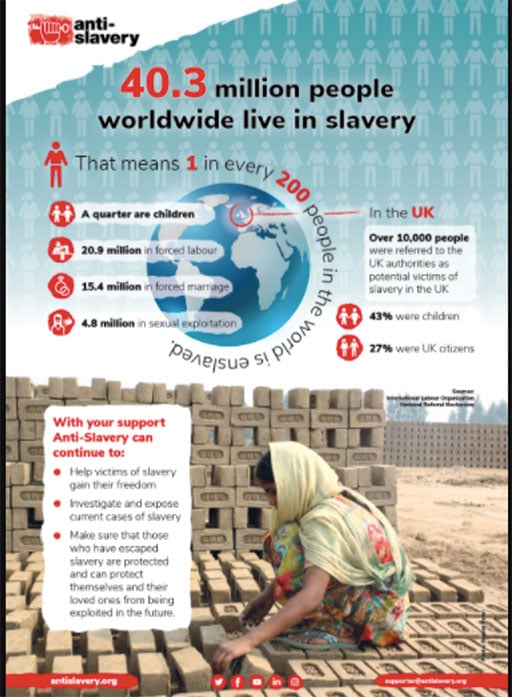
Not Just About Sex
Human trafficking is also about more than sex trafficking, according to a Department of Homeland Security Report entitled “Strategy to Combat Human Trafficking, the Importation of Goods Produced by Forced Labor And Child Sexual Exploitation.”
“Globally, forced labor is estimated to be the predominant form of human trafficking, far more prevalent than sex trafficking,” the U.S. Department of Homeland Security reported. “In many cases, inadequate rule of law, high crime and poverty rates and cultural norms contribute to the epidemic of forced labor. A lack of transparency in complex, extensive global supply chains or a lack of attention to the problem of forced labor can endanger the lives of laborers and negatively impact consumers and corporations.”
Final Lesson
While transportation professionals work to help victims, there is one final lesson. These victims are in our everyday lives and, as Rivard said, we all have a responsibility to be aware of trafficking and take action that could actually save lives. Clearly, it is incumbent on all of us to be trained to identify trafficking victims and help.
